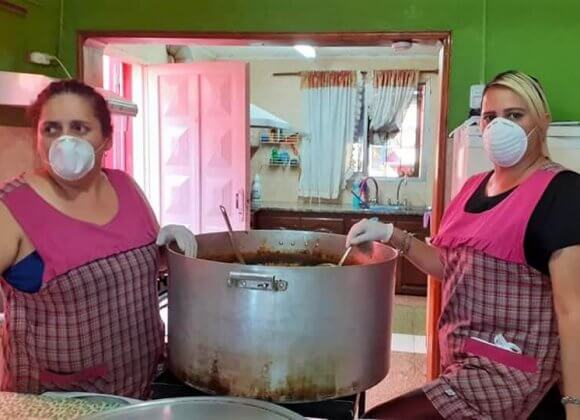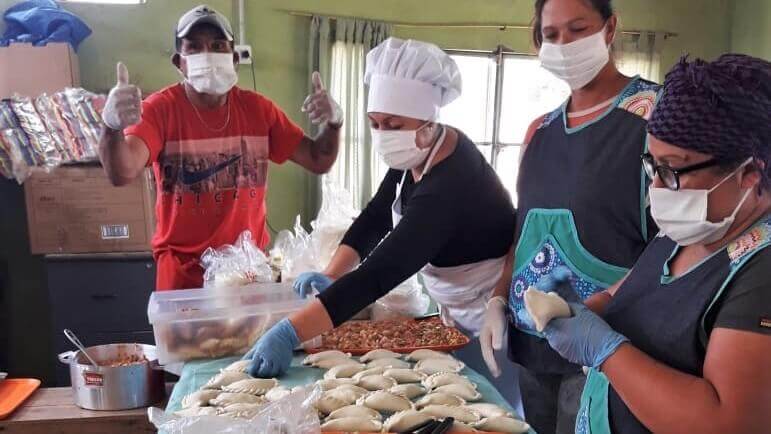By Mora Laiño
Translation: Laura Fujtey and Lucila Sörös.
We have almost lost count of the days we have been on social isolation as a preventive measure in the face of the expansion of coronavirus.
A million methods to take care of ourselves physically, emotionally, spiritually and digitally, offered by the self-care industry and conceived to guarantee individual well-being, exist along with fake news, memes, video calls and conspiracy theories among the middle-class population.
However, when looking beyond one’s own lockdown, we can see another phenomenon. The pandemic is putting some matters at the forefront: the value of collective answers in the face of the crisis, the recognition of care tasks, and the importance of having public policies aimed at guaranteeing healthcare for everyone and the access to basic human rights, without discrimination. This situation unveils how society organises itself as from reciprocity logics and the different strategies elaborated to continue the isolation as each person is able to, according to the possibilities and resources available to them.
The “Stay at Home” message for those who have a rather good economic situation is reset as a class privilege. The health crisis uncovers which jobs, activities and human lives are the ones sustaining our individual and social lives, which symbolic and economic reward they usually earn, and what happens when all this is altered.
In the different life experiences of isolation, the ways in which care tasks are managed become exposed; these are tasks that are feminised, dehierarchised and badly paid in our society. It is women who are mostly in charge of these activities, in particular those connected to health and home, and also the reproductive work that sustains our society.
The pandemic has also unveiled the differential impact of the crisis on the diverse social groups in an unequal socioeconomic structure. For the most disadvantaged communities in Argentina, the “Stay at Home” message makes evident what it is like to live in permanent fragility and uncertainty.
There, social organisations, the State’s community advocates and neighbourhood referents play a key role in providing food. Apart from organising prevention and awareness campaigns among locals, they work as a scaffold to support these people, in a context of reduction of informal work, which in disadvantaged neighbourhoods stands at around 80%, and which has brought about more need for food.
In this new situation, everything is growing exponentially: the risk of getting infected by coronavirus, but also the symptoms of precariousness and structural poverty that deepen inequality.
According to data from the Social Debt Observatory, towards the end of 2019, 2 out of 10 children between the age of 0 and 17 were living in overcrowded conditions and a similar proportion shared a bed or a mattress to sleep. The deficiency in housing hinders the population´s ability to comply with the mandatory social isolation regulations, which leads to stigmatizing looks for violating the quarantine.
About 16% of households from the vulnerable neighborhoods are in a situation of serious food insecurity. The lack of unskilled labor together with the suspension of classes has impacted the need to strengthen food assistance. With the crisis, the police violence has also become worse and also the gender-based violence since living together has become compulsory.
Around 17% of the households from the vulnerable neighborhoods has no access to the running water supply network, while a 42% lacks the connection to the sewage system. The lack of access to basic human rights prevents people from complying with the basic health recommendations.
In this context, the connectivity and the technological devices play a key role in the access to information, communication, entertainment and online procedures. Towards the end of 2019, 23% of the households from vulnerable neighborhoods did not have access to any type of internet connection, be it routed in the household or through a mobile device.
These asymmetries have a strong impact on the capacity to adapt the school education learning processes to the virtual world. In the rural communities of Argentina, that are already isolated and dispersed due to its geographical characteristics, the technology gap poses as a barrier to educational opportunities and ways of recreating community bonds to fight the fear. This technology gap deepens the isolation, the lack of information and the uncertainty. It has an impact on educational processes, the carrying out of subsidy procedures, and digital socialization.
But in the same way this crisis makes inequalities visible, it also makes it possible to bring a new and necessary perspective, one based on solidarity and empathy. Those perspectives that demonstrate how the collective organization is always the essential pillar that holds the social fabric, designing novel strategies for the management of the basic needs; making face masks, guaranteeing the care and feeding of old people, assisting cases of gender-based violence or improvising health care centers.
Maybe this future filled with speculations demands a new pedagogy of care that helps us change the stories based on success, self-improvement, individual wellbeing for others that value the common good and allow us to rethink the ways in which we organize and come together as a community also after the pandemic.
 |
 |
Casa del Niño en Bernal Oeste, Quilmes |
El Polito en barrio Zepa B, Córdoba |


